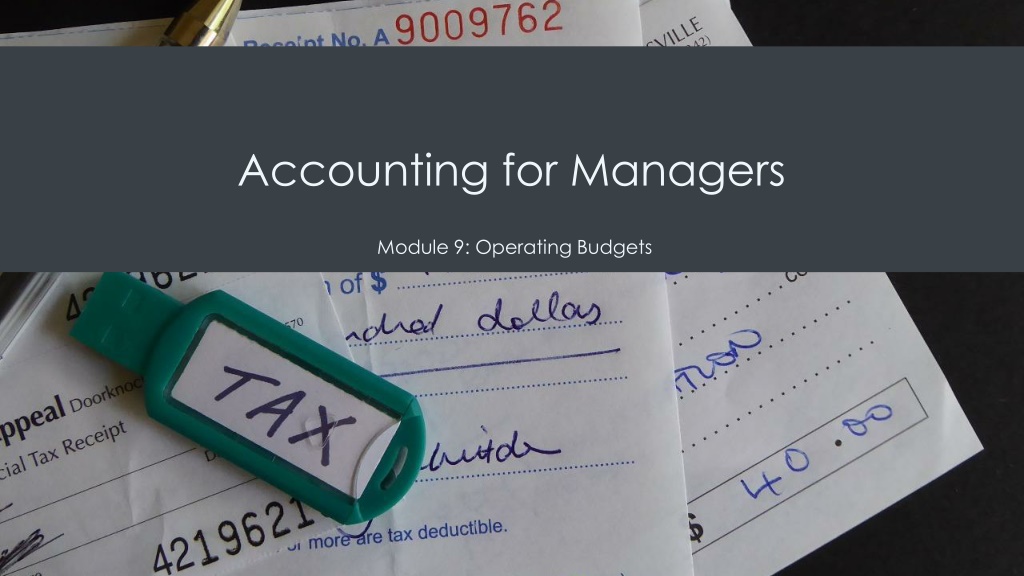
Mastering Operating Budgets for Effective Business Planning
Discover the essentials of operating budgets for managers, including responsibility accounting, alternative budget periods, and self-imposed budgeting. Learn how to prepare a master budget, analyze sales forecasts, and understand the components crucial for successful budgeting. Take control of your business finances with expert insights and strategies.
Download Presentation

Please find below an Image/Link to download the presentation.
The content on the website is provided AS IS for your information and personal use only. It may not be sold, licensed, or shared on other websites without obtaining consent from the author. Download presentation by click this link. If you encounter any issues during the download, it is possible that the publisher has removed the file from their server.
E N D
Presentation Transcript
Accounting for Managers Module 9: Operating Budgets
Budgeting and Business Common expenses a business may have: Rent Utilities Telephone Insurance Advertising Materials for product production Payroll Taxes
Responsibility Accounting As a manager, it is important to take the initiative to review the budget and analyze variances to determine a plan of corrective action. You, as a manager, can only be held responsible for the things you can control.
Alternative Budget Periods What do you do if the standard quarterly budget doesn t fit your needs? Two primary budget periods: One year budgets Continuous budgets Set a budget that works for your business!
Self-Imposed Budgeting Advantages of a self-imposed or participatory budgeting: Creation of a team environment where their views and budgets are valued by company management Working knowledge to more accurately estimate expenses for your area You are more motivated to set goals that are challenging, yet attainable
Sales Forecast and the Master Budget The master budget contains multiple components Sales budget is the most important You cannot do anything from a budgeting standpoint until you have a budget number from the sales department The sales budget feeds into: The production budget The finished goods inventory budget The cash budget Income statement Balance sheet
Components of the Master Budget Take a look at this master budget. It is important to prepare components of the sales budget in order, as information from one component is needed to complete the other.
Production Budget Hupana Running Company Production Budget: Q1 Q2 Q3 Q4 Totals 500 500 500 500 2000 Budgeted Unit Sales 50 50 50 150 300 Desired Finished Goods Inventory 550 550 550 650 2300 Total need 100 50 50 50 250 Less beginning finished goods inventory 450 500 500 600 2050 Required production units
Direct Materials Budget Questions to consider when making a direct materials budget (from the Hupana Running Company scenario): How many units of raw materials are required for each pair of shoes? How many units do we need to meet our production budget? How many units of raw materials would we like to have in our ending inventory? What do we currently have in our raw materials inventory? How many units of raw materials do we need to purchase? How much does each unit of raw material cost?
Direct Labor Budget Hupana Running Company Direct Labor Budget (1 shoe = .5 labor hours @ $20/hour average) Q1 Q2 Q3 Q4 Total 450 500 500 600 2050 Required production in pairs 0.5 0.5 0.5 0.5 0.5 Direct labor hours-pair 225 250 250 300 1025 Total direct labor hours needed $20 $20 $20 $20 $20 Direct labor cost per hour $4,500 $5,000 $5,000 $6,000 $20,500 Total direct labor cost
Manufacturing Overhead Budget Manufacturing overhead includes all the costs of production other than labor and raw materials. This can include some variable and some fixed components Variable manufacturing overhead: based on direct labor hours Fixed manufacturing overhead: depreciation on equipment, rent or mortgage on the facility, and costs to process purchase orders, customer calls and such.
Selling and Administrative Budget Hupana Scenario: Assumptions to make before tackling this kind of budget: Based on prior year s actual expenses, let s assume that the variable selling and administrative expenses are $5 per pair of shoes Let s assume that executive salaries, insurance, marketing, property taxes and depreciation are our fixed expenses All of the expenses are equally distributes over the four quarters of the year
Cash Budget What is included in a cash budget? How is a cash budget similar to your personal budget? What things might you find in your personal budget?
Budgeted Income: Example Example: Hupana Running Company Budgeted Income Statement Category Amount (USD) Sales $200,000 Costs of goods sold $52,000 Gross margin $148,000 Selling and administrative expenses $41,000 Net operating income $107,000 Interest expense $ Net income $107,000
Budgeted Balance Sheet The balance sheet gives us a snapshot in our budgeted time Assets = Liabilities + Stockholders Equity
Shortcomings of Static Budgets Biggest pitfall: An inability to adjust for changes in sales levels! This is a big problem, since an increase in sales levels is usually a good thing.
Flexible Budget Report Flexible budgets take into account how changes in production affect cost If production goes up, costs go up If production goes down, costs go down This allows for a more successful and profitable business
Flexible Budget reports and Multiple Cost Drivers A cost driver is defined as the unit of activity that causes a change in the activity s cost Determining the most important cost driver is crucial as a component of budgeting.
Quick Review What are the different types of budgets? Sales forecast Production budget Direct materials budget Manufacturing overhead budget Ending inventory budget Selling and administrative budget Cash budget Budgeted income Budgeted balance sheet What order should they be used in? Static vs. Flexible budget
